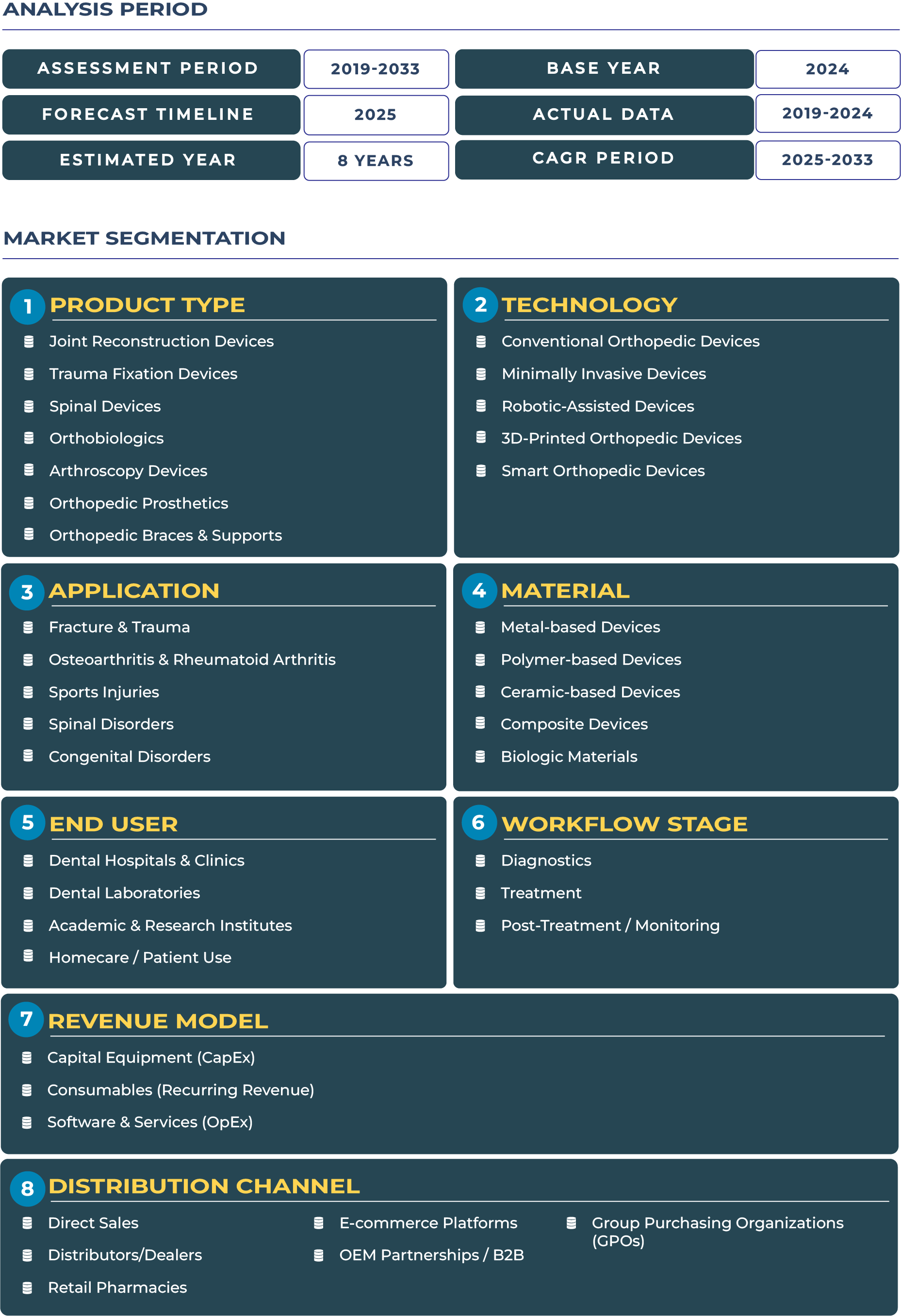Report Format:
![]()
![]() |
Pages: 110+
|
Pages: 110+
Argentina Orthopedic Devices Market Outlook: Balancing Reform Momentum with Economic Volatility
Argentina’s healthcare landscape is navigating a delicate balance between reform-driven progress and macroeconomic instability. In this evolving environment, the orthopedic devices market is emerging as a critical pillar of surgical innovation and patient rehabilitation. The country’s strong base of orthopedic surgeons and private hospital clusters continues to sustain demand for implants, prosthetics, and trauma fixation devices, despite the challenges of reimbursement unpredictability and currency volatility. According to DataCube Research, the Argentina orthopedic devices market is valued at USD 485.4 million in 2025 and is projected to grow to USD 803.7 million by 2033, reflecting a CAGR of 6.5% during 2025–2033. This growth trajectory highlights a market that is reform-driven, resilient, and primed for new models of healthcare delivery despite its economic headwinds.
Reform-Driven Expansion Strengthening Argentina Orthopedic Ecosystem
The orthopedic devices industry in Argentina reflects the broader national healthcare reform agenda, where efforts to expand coverage and improve surgical care remain central to public policy. The government, through the Ministry of Health, is enhancing orthopedic service delivery within public hospitals while private clinics capture demand for advanced implants and minimally invasive procedures. A rising elderly population and increasing cases of sports-related injuries are creating strong demand for knee and hip implants, as well as spinal devices. Additionally, orthobiologics and arthroscopy devices are gaining traction due to evolving surgical practices. Despite financial pressures, the demand outlook remains positive as orthopedic device adoption is increasingly viewed as essential for quality of life improvements. This reform-aligned expansion signals that orthopedic devices will continue to represent one of Argentina’s most resilient and progressive medical technology segments over the next decade.
Growth Catalysts and Constraints Defining the Argentina Orthopedic Devices Industry
Strong clinician expertise and private hospital clusters accelerate adoption
Argentina boasts one of the strongest clinician bases in Latin America, with orthopedic surgeons recognized for their advanced skills in joint reconstruction and spinal procedures. This pool of highly skilled professionals has been instrumental in driving adoption of innovative orthopedic devices. Private hospital clusters in Buenos Aires, Córdoba, and Rosario are expanding orthopedic surgical capacities, offering patients access to advanced technologies such as robotic-assisted joint replacements. The combination of clinical expertise and modern private sector infrastructure ensures that Argentina Orthopedic Devices ecosystem continues to evolve despite external economic uncertainties.
Macroeconomic instability and reimbursement unpredictability create market hurdles
At the same time, the orthopedic devices sector faces notable challenges. Persistent macroeconomic instability, marked by high inflation and fluctuating currency controls, has increased the cost of importing orthopedic implants and prosthetics. Reimbursement unpredictability within the public health insurance system creates further uncertainty for patients seeking advanced surgical solutions. These dynamics force healthcare providers to adjust procurement and pricing strategies, leading to uneven accessibility. Currency volatility not only inflates costs for imported devices but also complicates long-term investment planning for multinational suppliers. These hurdles highlight the importance of distributor financing models and localized solutions to maintain device adoption levels across the country.
Trends and Opportunities Shaping Argentina Orthopedic Devices Landscape
Private clinics expand urban footprint and leverage medical tourism niche
A growing trend in Argentina Orthopedic Devices market is the rapid expansion of private clinics in urban centers, particularly Buenos Aires. These institutions are positioning themselves as hubs for advanced orthopedic surgeries, including arthroscopy and complex joint reconstructions. Additionally, Argentina is building a medical tourism niche, attracting patients from neighboring countries seeking cost-effective orthopedic surgeries. Supplier financing agreements with hospitals and clinics are also becoming more common, enabling smoother procurement cycles despite economic volatility. Together, these trends are driving modernization across the orthopedic devices sector.
Local distributor financing and private clinic collaboration unlock new opportunities
The Argentine market offers significant opportunities for companies adopting innovative financing and partnership models. Distributor financing is increasingly seen as a critical enabler, helping hospitals manage device imports without bearing full upfront currency risks. Private clinic collaborations are also central to the orthopedic devices ecosystem, with value implant lines tailored to different income groups gaining traction. Furthermore, long-term clinical training programs for orthopedic specialists are expected to support the adoption of advanced devices, ensuring both affordability and clinical excellence. These opportunities present a roadmap for sustainable growth in Argentina Orthopedic Devices sector.
Competitive Landscape: Strategic Collaborations and Flexible Pricing Define Market Moves
The competitive landscape of Argentina Orthopedic Devices market is characterized by both multinational leaders and local distributors adapting to macroeconomic conditions. Companies such as Smith+Nephew and domestic orthopedic suppliers are focusing on flexible pricing models to align with affordability challenges. Insurance partnership pilots are also being tested, offering partial reimbursements for orthopedic implants in collaboration with private insurance providers. Additionally, localized distributor financing strategies are helping maintain market fluidity despite economic uncertainty. For instance, suppliers are bundling financing with implant procurement, allowing hospitals to sustain patient demand for trauma fixation and prosthetic devices. These strategies highlight the adaptability and resilience of Argentina Orthopedic Devices industry, positioning it for long-term relevance in the region’s healthcare landscape.







